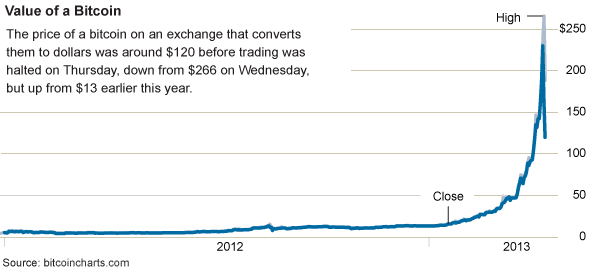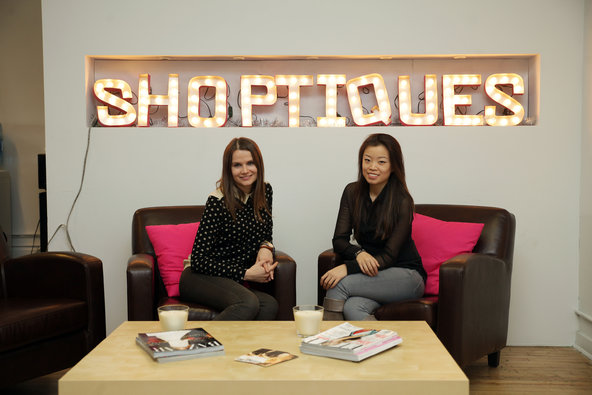The Winklevoss twins, Cameron and Tyler — Olympic rowers, nemeses of Mark Zuckerberg — are laying claim to a new title: bitcoin moguls.
The Winklevii, as they are known, have amassed since last summer what appears to be one of the single largest portfolios of the digital money, whose wild gyrations have Silicon Valley and Wall Street talking. The twins, the first prominent figures in the largely anonymous bitcoin world to publicly disclose a big stake, say they own nearly $11 million worth.
Or at least $11 million as of Thursday morning — when trading was temporarily suspended after the latest and largest flash crash left a single bitcoin worth about $120 and the whole market worth $1.3 billion. At one point, the price had plummeted 60 percent.
To skeptics, the frenzy over the bitcoin network created by anonymous programmers in 2009 looks more like the mania for Dutch tulip bulbs in the 1600s than the beginnings of an actual currency.
“To say highly speculative would be the understatement of the century,” said Steve Hanke, a professor specializing in alternative currencies at Johns Hopkins University.
Whatever else it is, bitcoin has become the financial phenomenon of the moment.
In addition to the identical twins, Silicon Valley investment firms, while not holding bitcoins, are starting to show interest in the technology.
On Thursday, a group of venture capitalists, including Andreessen Horowitz, announced that they were financing a bitcoin-related company, OpenCoin.

The Winklevosses say this week’s tumult is just growing pains for a digital currency that they believe will become a sort of gold for the technorati.
“People say it’s a Ponzi scheme, it’s a bubble,” said Cameron Winklevoss. “People really don’t want to take it seriously. At some point that narrative will shift to ‘virtual currencies are here to stay.’ We’re in the early days.”
While little is known about the creator of bitcoin, or if it even was a single person, the work involved serious programming chops, building a system that could live on borrowed computer space around the world. It was determined that only a finite number of bitcoins could be created — the count is currently around 11 million. New coins are “mined” by programmers who solve mathematic riddles and can sell their coins on upstart exchanges.
For now, there are few places where bitcoins can be used. One marketplace is an online bazaar, Silk Road, where narcotics are reportedly the main wares for sale. But bitcoin believers imagine a future where the e-cash can be used at their local Starbucks. The Winklevosses have paid in bitcoin for the services of a Ukrainian computer programmer who has worked on their Web site.
“We have elected to put our money and faith in a mathematical framework that is free of politics and human error,” Tyler Winklevoss said.
This is not the brothers’ first gamble on an unproved technology. As students at Harvard, the twins founded a social networking site, ConnectU, and enlisted their schoolmate, Mark Zuckerberg, to help them build the company. After Mr. Zuckerberg went off to start Facebook, the brothers sued him, accusing him of stealing their idea — a story that was dramatized in the movie “The Social Network.” The case was settled with the brothers being given $20 million in cash and Facebook shares that are now worth more than $200 million.
They have parlayed that fortune into Winklevoss Capital. Their first two investments were in Hukkster, a start-up shopping Web site and SumZero, an online community for professional money managers.
The brothers began dabbling in bitcoin last summer when the dollar value of a single coin was still in the single digits. To keep their holdings secure from hackers, they have taken the complex codes that represent their holdings off networked computers and saved them on small flash drives, putting the drives, in turn, in safe deposit boxes at banks in three different cities.
It’s hard to verify how the Winklevoss holdings compare with other bitcoin players, given the anonymity of accounts, and the twins say they believe that some early users of the system probably have holdings that are at least as large.
A Maltese company, Exante, started a hedge fund that the company says has bought up about 82,000 bitcoins — or about $10 million as of Thursday — with money from wealthy investors. A founder of the fund, Anatoli Knyazev, said his main concern was hackers and government regulators, who have so far mostly left the currency alone.
These investments were all in an uncertain state on Thursday after the big price swings and the shutdown of trading on Mt. Gox, a Japanese-based company that claims to handle 80 percent of all bitcoin trades. Mt. Gox said in a statement that the problems were a result of the currency’s popularity, making it impossible to process all the incoming orders. It added that it was not the victim of hackers but “instead victim of our own success!”
The 6-foot-5 Winklevoss brothers were unfazed. The brothers said they took advantage of the low prices to buy more.
“It has been four years and it has yet to be discredited as a viable alternative to fiat currency,” Tyler Winklevoss said. “We could be totally wrong, but we are curious to see this play out a lot more.”
Article source: http://dealbook.nytimes.com/2013/04/11/as-big-investors-emerge-bitcoin-gets-ready-for-its-close-up/?partner=rss&emc=rss


